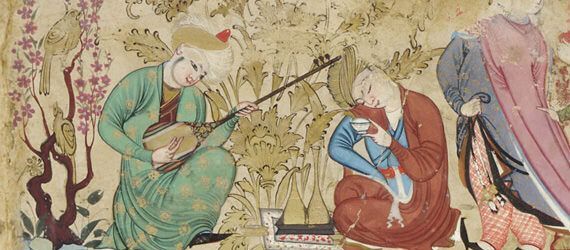may list the next pages here
Traditional Persian Instruments
Traditional Instruments in Persian Paintings
Iranian Classical Music Ensembles
← Go back Next page →
Classical Persian music is an ancient art form and one of the earliest musical traditions known today. Because of the geographic location and sociopolitical role of the ancient Persian Empire, Persian music and culture has contributed enormously to the foundation of many other musical traditions in Central Asia, Asia Minor, China and North India. Since becoming associated with Islamic culture after the Arab invasion (7th century AD), it has traveled throughout the Middle East, North Africa and the Mediterranean.
The classical music of Iran is in some ways similar and analogous to the classical music of the Arabic world, Turkey and even India, but it is also a self-contained system more or less independent of its neighbors. In the twelfth century, a second system, that of Western classical music, has grown up parallel to that of the Persian art, and today the two coexist, largely leaving each other alone but in various ways cross-fertilizing each other.
The history of Persian music in the twentieth century has seen the development of strategies for survival in the face of Western music, and these strategies often involved borrowing from those elements in which Western music is strong. For example, Western notation has been adapted to Persian music and while it has done its share to change the character of Persian music, it has also increased the degree to which Iranian music students are willing to learn their tradition.
Persian music is mainly melodic. It makes almost no use of harmony, and its performance is most typically solo, although sometimes a soloist is accompanied by an instrument which echoes and recapitulates each phrase as the artist performs it, a technique also widely used in Arabic, Turkish and Indian music. Its essence is neither the dramatic nor is it the intellectual or cerebral, but rather its quality is mystical and contemplative. Persian musicians recognize this, for in speaking of their music they never fail to relate it to the great lyrical tradition of Persian literature and to Sufism, the mystical movement of Islam whose special home is Iran.
Much of the music has no meter, no beat, but proceeds with a rhythm akin to that of speech. Its rhythmic structure is surely related to the rhythms of Persian poetry. Nevertheless, there is also a great deal of metric music, and this, normally accompanied by a drum.
Improvisation is the most important tenet of classical music of Iran. The musician creates in the moment and simultaneously performs for the audience. The presence and spirit of the audience plays an important role in the feeling and the creative process of the improvisation. The improviser combines creativity and technique with the internalized melodies and rhythms to express his or her individual feelings. To become an improviser is to reach the ultimate stage in the musician's creative development. To reach such a level of mastery the musician must be rich in technique, emotions, innovation, experience and knowledge. The musician becomes a master once he or she has achieved such a level of virtuosity and has cultivated the art of performance and teaching.
Source: http://worldmusiccentral.org/article.php?story=20030414200427528

